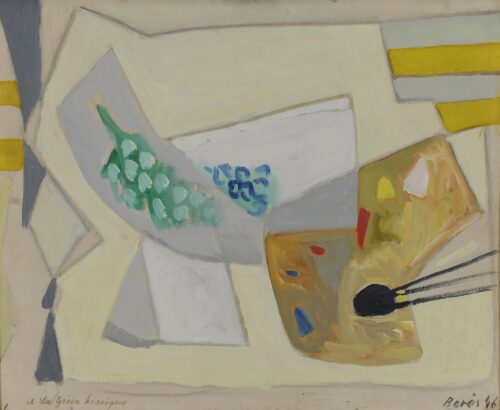
Bores Francisco (1898 - 1972)
Palette and Fruit Bowl, 1946
He began his studies at a free academy in Madrid and at the same time worked at the Prado, primarily copying the works of Titian, Velasquez and Goya. He linked himself to the avant garde groups in Madrid and worked for many newspapers as an illustrator. Until that period his works were presented frequently at the various salons and were rather conventional. In 1925 twenty of his works were included in an important exhibition in Madrid called “Iberian Artists”, which for the first time presented the work of non-academic painters. Immediately after that, he settled in Paris and associated himself with various Spanish painters among whom were Picasso, Miro and Picabia. He became friends with Matisse, Derain and Juan Gris.
In Paris he participated in many group exhibitions, such as the Salon of True Independents and the Salon des Tuileries, to which he was invited to participate. He also took regular part in the Salon des Superindependants, as well as in the exhibition of the School of Paris which was held in Bern in 1946.
His first solo exhibition was held at the Percier Gallery in Paris and presented works inspired by cubist collage.
He subsequently had many solo exhibitions, not only n Paris but also in Madrid, Zurich, Brussels, Stockholm, Copenhagen, Chicago, Los Angeles and New York.
During the early Thirties his style drew closer to Expressionism, mainly because of his sinewy and intense brushstroke and his drawing done straight n the canvas. Later, he turned toward strictly intellectual compositions, using his themes as a pretext for stylistic experiments. The influence of Cubism was particularly strong, something which would appear to have been unavoidable for a young painter in the Paris of that period. He belonged to a group of artists for whom Cubism offered a new way of working which supplied an answer to their need to organize the work of art in a strick manner.
His Cubism was characterized as “Cubism with curves”. In his work can be recognized the influences of Picasso, Gris, Matisse and Braque.
He gradually simplified his painting, frequently achieving near abstraction. His work is characterized by an acuteness of color and the complex use of space, and is imbued with mysticism, creating an atmosphere all its own.

Palette and Fruit Bowl, 1946

We use cookies to make our site work properly, to personalize content and ads, to provide social media features and to analyze our traffic. We also share information about how you use our site with our social media, advertising and analytics partners. Read the Cookies Policy.
These cookies are necessary for the website to function and cannot be switched off in our systems. They are usually only set in response to actions made by you which amount to a request for services, such as setting your privacy preferences, logging in or filling in forms. You can set your browser to block or alert you about these cookies, but some parts of the site will not then work. These cookies do not store any personally identifiable information.
If you disable this cookie, we will not be able to save your preferences. This means that every time you visit this website you will need to enable or disable cookies again.
These cookies tell us about how you use the site and they help us to make it better. For example these cookies count the number of visitors to our website and see how visitors move around when they are using it. This helps us to improve the way our site works, for example, by ensuring that users find what they are looking for easily. Our website uses Google Analytics for statistics reporting.
Please enable Strictly Necessary Cookies first so that we can save your preferences!